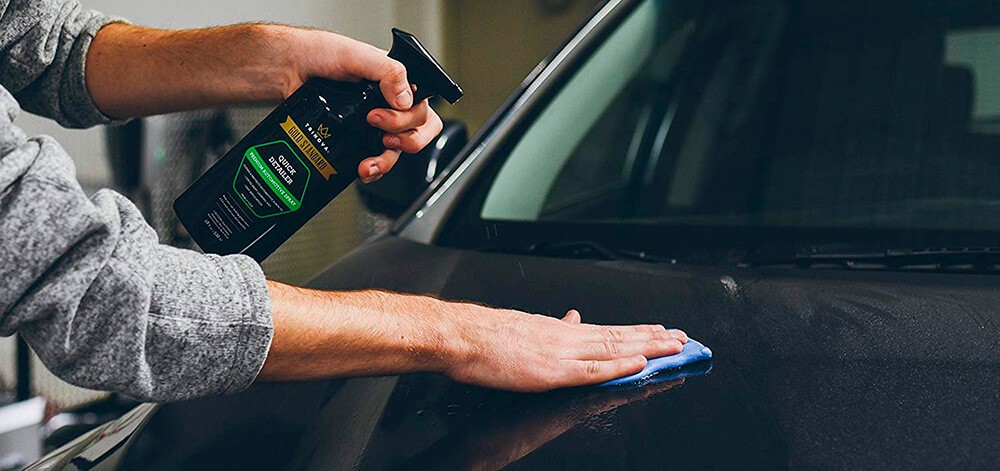
Applying a clay bar is an effective way to extract the slightest alien particles from the paintwork making it smooth and glossy. Still, each car requires its own best clay bar. The age of the car and the paint, the smoothness of the paintwork, amount of debris and their contents, the chemicals previously applied all matter.
Simple as they are, the clay bars feature many parameters that can benefit the detailing or make it more complicated. The features to consider are the following:
- Softness / pliability. Depending on the softness type, the clay bar can be more or less efficient on the car finish. Softer bars are easier to use, as they work gently on a paint. The medium clay bars pick up deeper-lying contaminants; still, they can damage the paint, so, the application pressure should be well measured.
- Need for lubricant. While most of the detailing procedures require a good amount of oiling, some clay bars are already soaked in it. Other models might have a delicate texture preventing the damage to the car’s finish.
- Comfort of use. The light-colored clay bar shows clearly the state of the bar, while the dark one would conceal a good deal of contaminants on the bar. The size of the bar and its ability to be cut are important, too. Some bars are easily divided into parts, while others are less flexible.
Choosing the right clay bar requires preparation. Find your best clay bar for car — read on!
Clay Bar Reviews
Adam’s Visco Professional Detailing Clay Bar
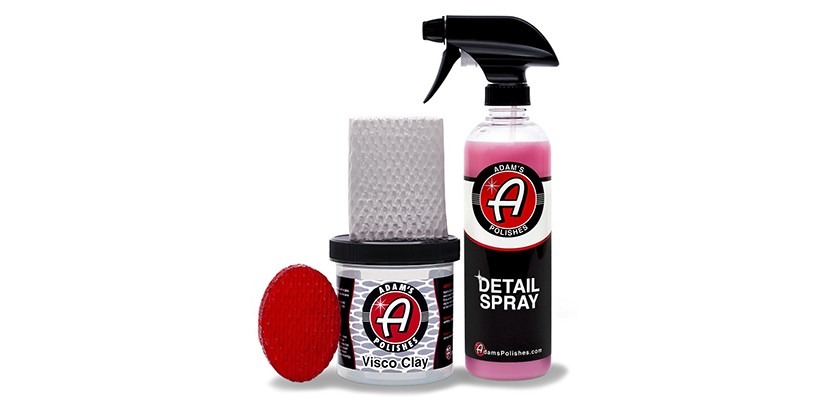
The clay bar is supplied along with the lubrication spray and a special tool-making detailing a manageable procedure even by novices. The high durability and affordable price let call this unit the best clay bar kit; still, due to the close-to-medium consistency, it requires some experience to apply correctly.
The waffle surface provides some stiffness to the bar making it easy to hold in a hand and glide along the surface. However, the pressure should be slight to secure the paint from smudges. It also soaks the lubricant swiftly; so, it’s important to be sure that there’s a spare bottle at hand when starting to clay.
The kit includes a Geo impression tool making the claying simpler. It lets stretch the clay bar and get an optimal thickness for detailing. The clay bar can be used on all the car surfaces including the lights, plastic parts, and metal.
Thanks to the waffle structure and the close-to-medium hardness, this clay bar is efficient at removing the old congealed contaminants, paint bumps, sticking residues like a glue, sealant, etc. It’s particularly good at extracting the micro litter from scratches and making the paint coating smooth and shiny.
Pros
- Long term of service — fit for detailing several cars.
- Good at removing the damp viscous resides (like motor oil, brake fluid, and so on).
- The clay bar is quite big and handy to use for people with big hands.
Cons
- Might leave a smudge if used without or with not enough lubricant.
- At the beginning of usage is rather stiff and doesn’t fold easily.
Meguiar’s Mirror Glaze Detailing Clay (C2100)
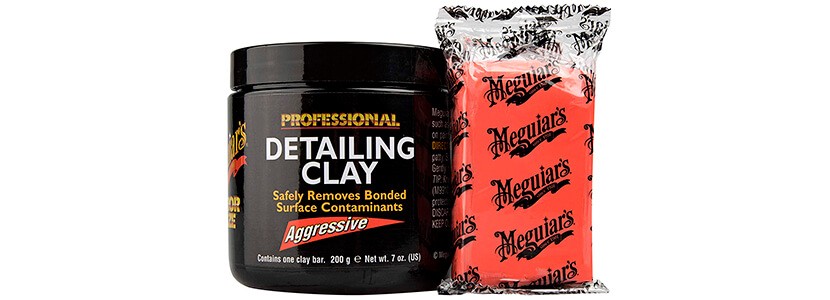
Efficient removal of the withered and congealed dirt and other contaminants, mild impact on paint and convenient storage option would let call this product the best clay bar. Yet, it’s pricing is on a high side, and the “aggressive” feature means that a professional or at least a good deal of experience in working with clay bar is needed.
This heavy-duty clay bar works well on surfaces with overspray paint or large deposits of contaminants. It’s labeled as “aggressive” meaning it has tiny grit embedded in the clay. Though the grit is very small and there aren’t many, using the aggressive clay bar often might lead to web-thin scratches and even some haze on a paint. However, if used properly and with caution, this clay bar allows working thoroughly and quickly.
The clay bar is quite big and can be either used in whole or be separated in parts, depending on the user’s convenience. It’s quite grippy and doesn’t require any effort while claying the car or another object. Run over the painted surface, it picks almost all the micro debris upon the light gliding and removes water stains, tree sap spots, road tar that’s already got piled up in the paint.
Pros
- Fit for old cars, picking up the paint contaminants on the upper paint layer.
- Leaves a shiny mirror-like effect.
- Comes in a handy storage container.
Cons
- Gets soft if applied in the direct sunlight.
- Expensive.
Mothers 07240 California Gold Clay Bar System
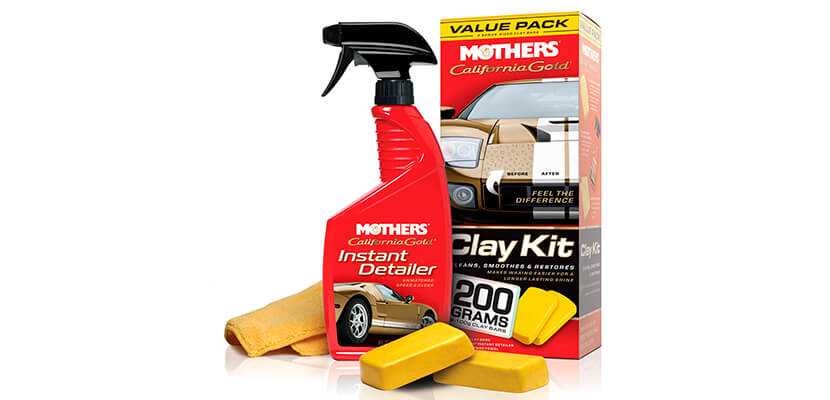
This car detailing kit is notable for the careful impact on the car’s paint and high efficiency on the low-to-medium contaminated surfaces.
The kit includes two pieces of the clay bar of a good size (fitting any hand), a detailer fluid and a microfiber towel. It offers everything needed for a quick and gentle claying and can be used even by the beginner in car care and detailing in particular.
The supplied clay bar is soft and well-pliable while holding its shape and not disintegrating even in the heat. It glides smoothly over the car surface, while the dirt-picking is well sensed by the user. While the clay bar is a mild type, it removes the road tar, dust deposits, and water spots quickly leaving a smooth surface. Because of the carefully measured impact, it can be used on multiple surfaces of the car including glass and plastic. Even a clear coated surface can be clayed, while the pressure to the clay bar should be very mild. However, the wax or another type of surface coating might be destroyed or peeled off by the clay.
Pros
- Makes the paint tint deeper and the overall surface clearer, with shiny effect.
- Fits for regular use even on brand-new cars.
- Efficiently removes overspray and paint bumps on different types of surface including chrome and plastic.
Cons
- The supplied lubricant gets dried fast leaving a residue.
- No reusable storage container provided.
Griot’s Garage 11291 Paint Clay and Speed Shine Kit
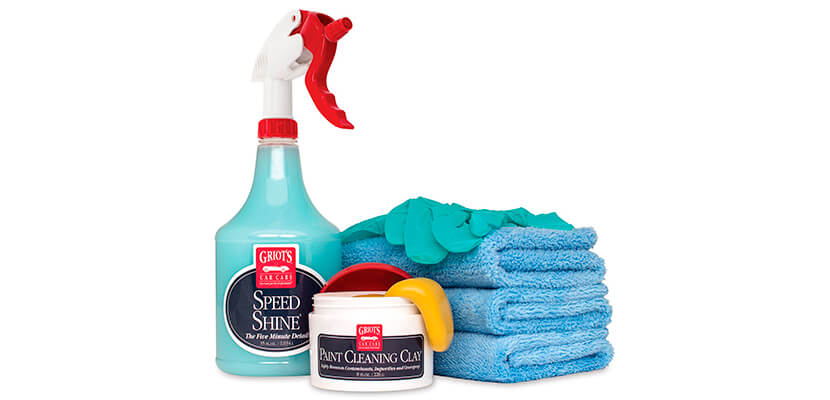
The car clay bar kit contains all the tools needed for claying a car including the vinyl gloves. Due to the high efficiency of the pollution specks’ picking, it creates a good basis for waxing the car right after claying.
Using this clay bar over a car hood, roof, and rims lets gather most of the debris deposited over the upper layer of the car paint. The clay bar isn’t too soft keeping its shape well; yet, it is flexible enough to knit effortlessly and glide easily.
The clay bar is efficient on multiple contaminant types including bird drops, brake dust, rust specks, water, and other liquid stains. It can also remove the oxidation haze from the lights since the item can be applied on glass, plastic, metal, and different kinds of paint and coating. Still, a film left over by waxes can be partly removed as well. It also works well on embedded contaminant pileups, while several passages with the clay bar over them might be required.
Folding and kneading the bar is quite easy, and it can be used several times without replacement. Even upon the usage on the wheels, it still offers a clean side to continue claying.
Pros
- Applied even over the old paints, restores the smooth and silk-feeling texture.
- A large bar is offered for the price; it can be split into at least three pieces.
- Enhances the color, adding depth and richness.
Cons
- Requires good lubrication — get stuck to paint without it.
- When separated into pieces, the smaller ones might crumble.
TriNova Clay Bar Kit
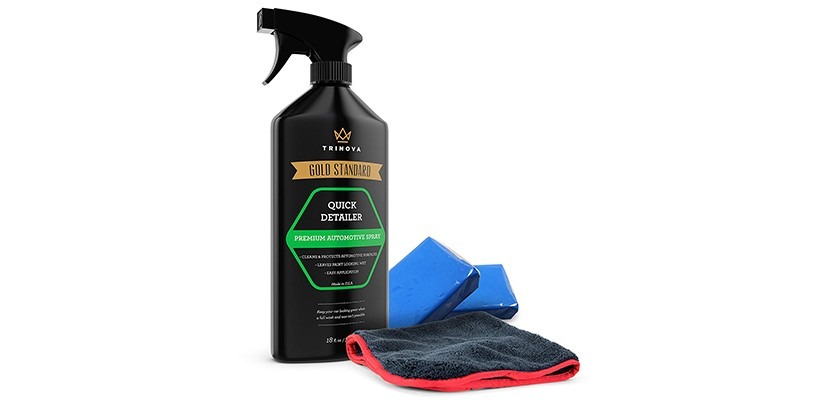
The detailing kit contains the items necessary for all stages of claying a car. Apart from the two clay bars, the lubricant fluid is supplied and the microfiber cloth (for wiping the lubricant residue upon claying). While this kit generally repeats the specifications of other items on the current list, it’s offered for a lucrative price, which is at least two times less than competitors’.
Included clay bar pieces are about 3.5 oz each, packed in the disposable plastic bags. They feel hard at the beginning, while active kneading makes them soften. The clay itself is a medium hardness one, which is good for peeling off the large oversprays or obvious contamination pileups. However, it requires an experienced user for detailing, as applying too much pressure might result in paint scratching and smudging on edges. No shortage of lubricant usage and spraying the clay with it as well ease up the claying procedure, letting the bar glide along with the paint.
The clay removes the dust, bird drops, metal crumbs efficiently, often upon a single up-and-down passage. Due to the highly sticky consistency, it extracts even the withered contaminants and quickly gets soiled. Meanwhile, it is less pliable than the soft clay bars and requires more effort to remold and expose a clean side.
Pros
- Efficiently removes the tarnish from the old paint layers.
- Works well on salt and chemical stains.
- Good grip, easy to hold in the hand.
Cons
- Doesn’t fit for clear coat decontamination.
- Requires slow careful operation; otherwise, it might leave micro-scratches.
Mothers 17240 Speed Clay 2.0
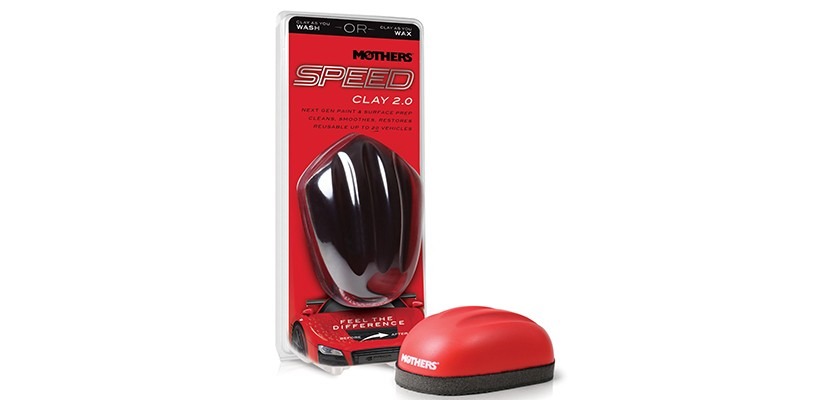
This single bar of auto detailing clay isn’t cheap, ultimately ensuring efficient, fast, and trouble-free vehicle claying. It’s durable and can be used on up to 20 middle-sized cars, not heavily contaminated.
The clay comes in a large single piece that can be separated for several small ones. It has a soft-to-medium hardness and, though not being aggressive, is aimed at going into the upper paint layer and picking the dirt embedded there. It works effectively on different types of automobile paint but doesn’t fit for a clear coat since it can leave scratch swirls or completely remove the coating film.
The clay bar consists of three layers of polymer, each one serving its purpose. The upper thin layer is grippy and reminds of a solid sponge structure. The lower level is more pliable and spongy, and the working surface (that contacts with the paint or another coating) feels yet more malleable. While the clay bar isn’t of the soft type, it’s easy to glide along and catches the contaminants efficiently even at quick claying.
The clay bar releases and picks the pileups of the brake dust and road tar. It can also polish the paint to some extent leaving a smooth surface with a mirror-shine effect.
Pros
- Rubber basis of the clay bar protects the fine paint layer from damage.
- Removes tarnish effectively from glass, paint, and plastic.
- Allows for long strokes making claying faster.
Cons
- Hard to trace clay getting dirty, as the lower layer is black.
- Has less efficiency on withered highly contaminated paint.
Chemical Guys Cly_109 Synthetic Lubricant Kit
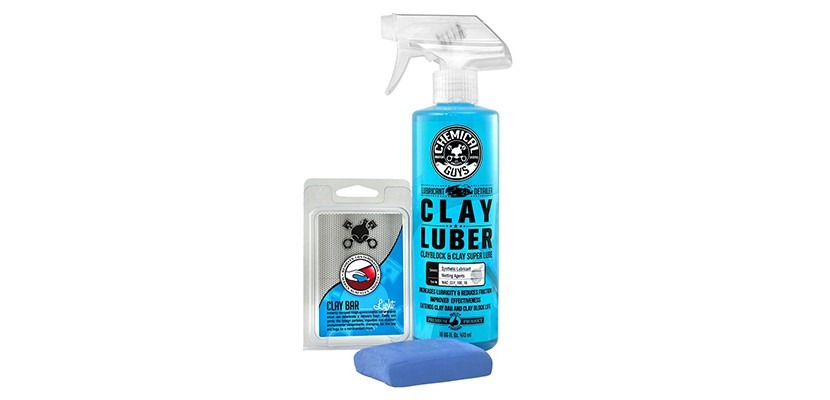
This clay bar kit is offered for a moderate price and provides a good value. It comes bundled with a car detailing clay and a lubricant spray bottle and can last as much as a thorough detailing of four cars.
The clay bar offered is a light-duty one, rather thin but very elastic. It’s made of synthetic compounds and has good grabby surface serving for catching the contaminants gathered on top of the vehicle paintwork. It doesn’t crumble at kneading and folding and is easy to operate even for inexperienced users. Besides, its non-abrasive and thus isn’t likely to harm the paintwork at the incorrect usage.
While this is not a tool for heavily contaminated old paint, it’s quite effective on newly painted and seemingly clean cars. Applying the clay bar restores the glossiness and shine of the paint, as well as takes out any roughness from the surface. It removes the road dust and tar, mild water stains, and the oxidation haze on the lights and works equally well on windows, hood, bumper, and rims.
The clay bar doesn’t stick to hands; yet, it’s quite easy to hold and doesn’t slide away even at the excessive use of the lubricant.
Pros
- High flexibility lets the clay bar glide along and “embrace” every curve on a car surface.
- Removes oversprays gently, letting control the depth of the removal.
Cons
- Upon claying, it leaves a blue residue on the hands.
- The clay bar can occasionally get sticky to the hands.
Buyer’s Guide
What is Clay Bar? A Brief Overview
A clay bar is a piece of a resin substance designed for picking the pollution particles that stick to the car, motorcycle, siding panel or another painted surface but can’t be removed with a thorough wash. These are micro contaminants, which, however, result in the paint dimming and feeling rough. A clay rod is used to remove them, leaving a smooth, non-stick surface that is an ideal base for polishing and waxing.
Clay bars can be made of natural compounds or synthetic ones, while the latter is the most often type used. They also differ by hardness and flexibility and they can be of soft or medium type.
What does Clay Bar Do to Car Paint?
The clay bar has a sponge-like structure, which effectively “grabs” the micro-particles of dust, tree sap, overspray paint, the industrial damage (rust marks), and so on. Soaked with the lubricant, it doesn’t stick to paint, gliding along its surface.
During claying, the bar (depending on its viscosity and structure) can catch more or less micro debris and deal with the upper layer of paint or go deeper. In the latter case, the clay bar should be operated carefully, as too fast or incorrect movement or too much pressure applied can cause the paint smudges and scratches’ appearance.
How to Use a Clay Bar on the Vehicle?
The preparation stage before claying is the same for all types of clay bars, while the actual application slightly differs depending on the grade of the clay (fine or medium). Follow the next steps for safe and effective claying of your car:
- Wash and dry the car thoroughly. Make sure the whole surface is free of dirt and dry (some recommend claying on a wet surface, which is also possible).
- Prepare the clay bar. If the bar itself is large, divide it into the pieces of about 2-2.5 oz. Take one piece and warm it up in your hands, then fold and kneed it to ensure it becomes elastic. If needed, spray the clay with a bit of the lubricant. Remold the bar into a thin “pancake” fitting in the palm of your hand.
- Choose the area. Select the place on your hood, roof or a fender approximately 4×4 ft.
- Soak the surface. Spray the chosen area lavishly with the lubricant, make sure that all the area is covered with the fluid.
- Apply the bar gently against the surface, sliding it back and forth (or left and right) on the picked area of a car. Make sure the pressure is light, and you just don’t let the clay fall down to the earth.
- When the worked-out area becomes smooth, proceed to another part of your car.
- Upon doing all parts, wipe the car with the microfiber towel. Remove the particles with a thorough wash, took out by the clay bar, completely from the surface.
How to Clay Bar a Black Car?
Claying a black car requires more caution and care due to the nature of the black paint. Here are some tips for detailing a black car:
- Moderate use. Clay bar your black car once in three months or so.
- Use additional care fluids. Iron and tar removers can help eliminate a part of the contamination making the claying process easier and faster.
- Use a clean clay bar only. Make sure the surface of the bar having contact with the paint, is pure. Otherwise, pick another piece of a clay bar.
- Remove the lubricant residue and contaminants took out by the clay bar with a thorough rinsing.

My name is Brandon, and I’ve been interested in cars since I was a kid. I got a bachelor’s degree in Automotive Technology and worked in a private car workshop. I have two cars that have been completely upgraded with my own hands. So I successfully put all my knowledge into practice.
Last update on 2026-01-01 / Affiliate links / Images from Amazon Product Advertising API
